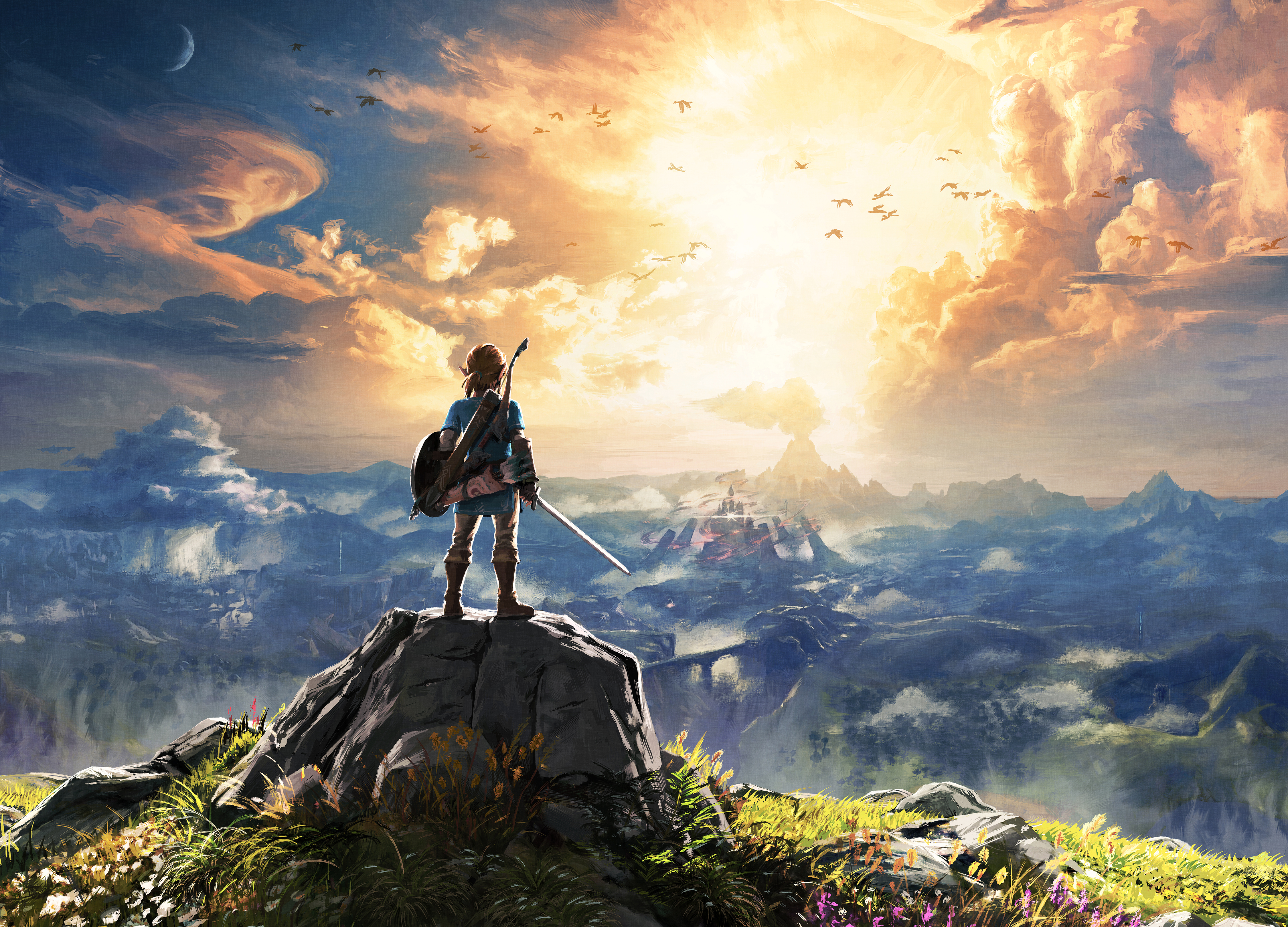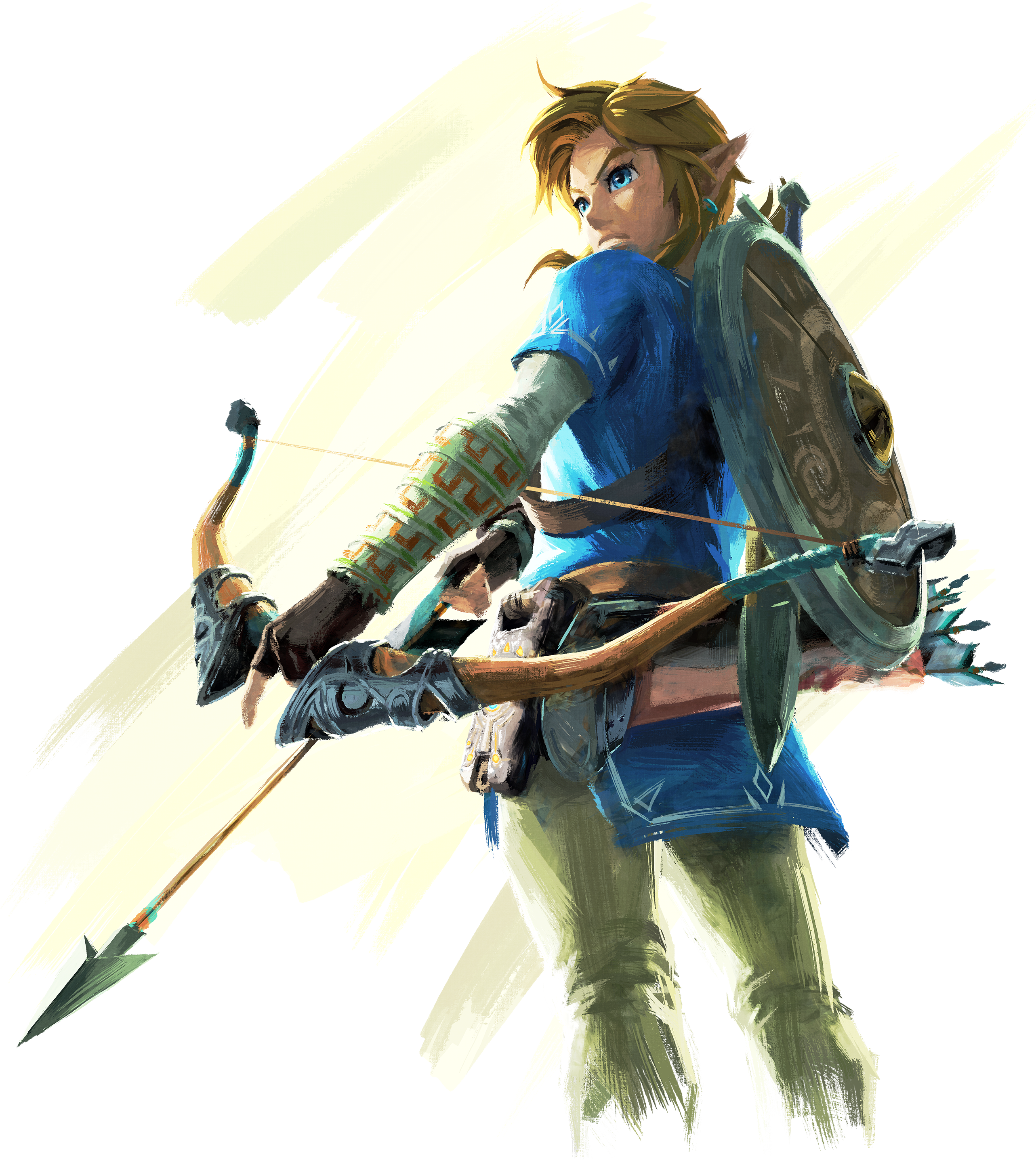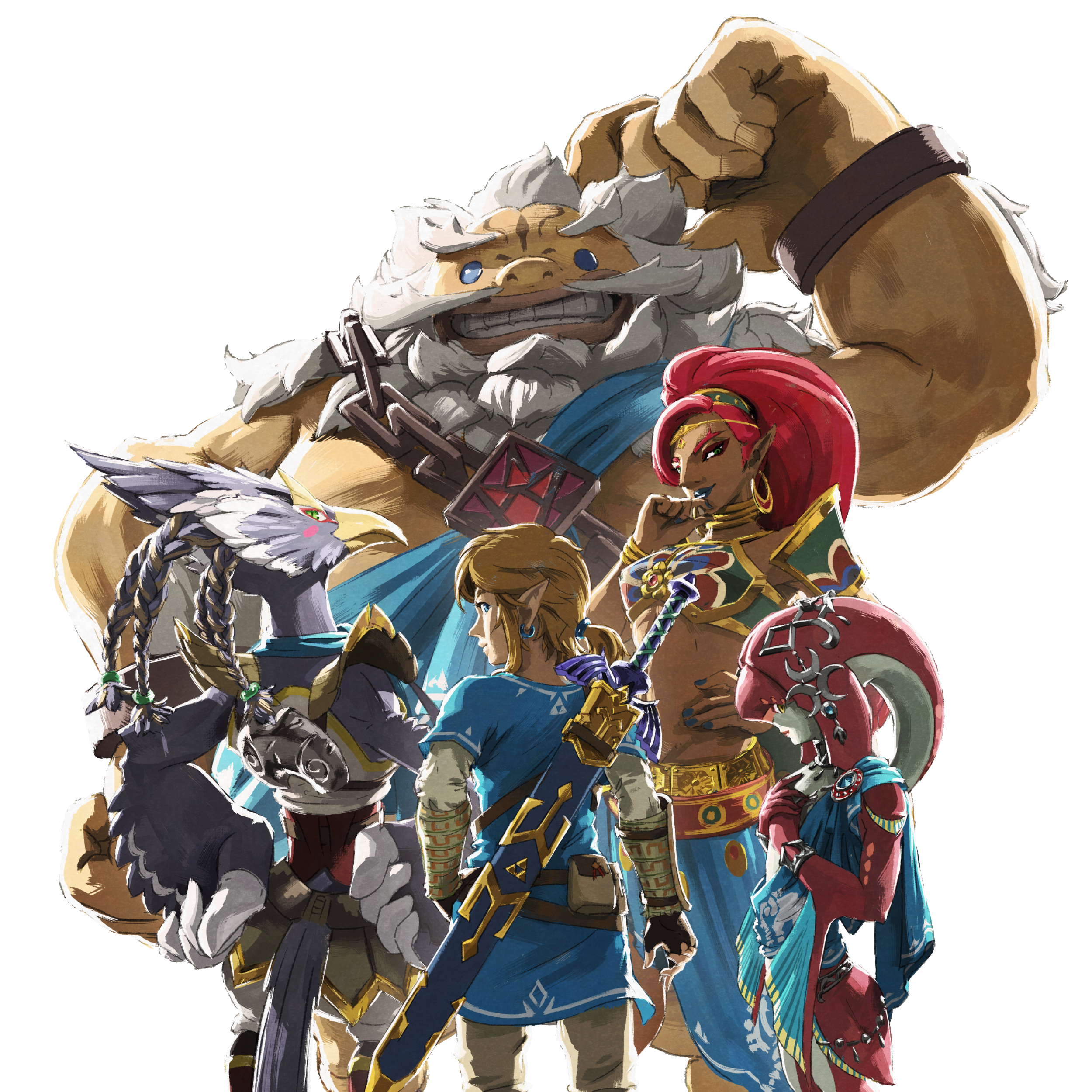Character Creation
Please download an offline copy of any page you may need. "Alt+Shift+P" can be used to make a printable PDF of any page. See also archives. | ||
|
Player's Guide |
System Reference |
Compendium
 |
Follow these steps below to create a legendary character — a hero — to represent yourself in the world of Hyrule.
You and your fellow players each control a hero in the world of legends weaved by your narrator. Just like in a video game, your hero is defined in part by numbers representing what they can do and by what items they have, but also by their appearance, their personality, their bonds, and their actions. These rules focus on the numbers, but be sure to consider what kind of person you want to portray in your ensuing adventures.
These rules are meant for a full campaign in Hyrule, with each game session representing a different adventure in the world explored by your party. If your campaign doesn't take place in Hyrule, use either the default character creation rules or whatever rules your narrator believes will work best for you. Whether creating a Hyrulean character or not, the first step is always to consult your narrator.
To record your character's details, you can use any typical character sheet for D&D. You can also jot them down on any parchment or Sheikah Slate you have handy.
Contents
Step 1: Ability Scores
One of the most fundamental aspects of a your hero are their numerical ability scores. The six scores are Strength, Dexterity, Constitution, Intelligence, Wisdom, and Charisma.
You can choose one of the four methods below to determine your ability scores. These methods are designed to be interchangeable. If one player wants to roll ability scores and another wants to use point-buy, the scores could be a little better or a little worse, but almost never to the extent either player will feel useless by comparison. However you generate your scores, be sure to record them.
Method A: Standard Array
You have six numerical scores: 14, 13, 12, 11, 9, and 8. You can assign these scores to your six abilities in whichever order you like.
This method creates a very balanced character. These scores can be easily optimized with your race and class to create an effective individual who still has room to grow, and doesn't have any glaring weaknesses.
Method B: Rolled Array
This is a good option if you want something a bit different, or want to take a chance at being above-average. If you would be disinterested in committing to a character with poor abilities, it is best if you choose a method other than this one. Considering this, your narrator might reasonably omit this option.
Roll 4d4+1, and record the number you rolled. Do this five more times, until you have six numbers. The six numbers you rolled become your six ability scores, which you can assign to your six abilities in whatever order you like—with one exception. If you roll a 7 or lower, you can't assign it to your Constitution.
If you don't roll at least one result above 7, which is unlikely, you can re-roll a completely new array. This is the mercy rule.
Probabilities. Before considering the mercy rule, this method's average result is 11, with a small chance of being as low as 5 or as high as 17. The most probable Rolled Array will be comparable to the Standard Array, but with possibilities for underpowered or overpowered spreads. There's a ~3% chance of scoring even a single 17 across all six rolls, and equally low odds of rolling a single 5. There's a ~30% chance you’ll roll a single score above 14.
| Score | Cost |
|---|---|
| 7 | 0 |
| 8 | 1 |
| 9 | 2 |
| 10 | 3 |
| 11 | 4 |
| 12 | 5 |
| 13 | 7 |
| 14 | 9 |
Method C: Point-Buy
This method gives you nuanced control over the exact numbers your ability scores can be, which may be a preferred result if you enjoy optimizing your character's capabilities.
You have 27 points to spend on your ability scores. The cost of each score is shown in the adjacent table. For example, a score of 13 costs 7 points. When using this rule, you can't assign a score of 7 to your Constitution.
This method cannot be used to decrease a score below 7 or increase a score above 14. You can't make an array quite as valuable as the Standard Array, but in exchange you get much more control over what your scores are.
Method D6 Spread
This can be a good option for an experienced player who is interested in creating a character around locked-in scores. All your ability scores start at 9. Roll 12d6, and tally the individual results of each d6.
- For each 1, increase your Strength score by one.
- For each 2 increase your Dexterity score by one.
- For each 3, increase your Constitution score by one.
- For each 4, increase your Intelligence score by one.
- For each 5, increase your Wisdom score by one.
- For each 6, increase your Charisma score by one.
This will end up with the same number of points in the Standard Array, minus 1. There’s a chance of very balanced scores or one extremely high locked-in score. Unlike the Rolled Array, there's no chance of all low scores or all high scores.
Step 2: Choose Class
Choosing a class has the most long-term impact on your hero's capabilities, especially those you employ in combat. Choose one from champion, opportunist, researcher, sage, and scion.
Depending on your choice, there are other decisions to make regarding your class, as detailed on each class's page. Champion is perhaps the simplest option initially. If you choose sage or scion, you will need to choose a subclass right away, but other classes let you get a feel for it before you commit to a subclass.
Speed. Your speed is how far you can move on each turn. You start with a walk speed of 30 feet, but your class and lineage may decrease or increase this distance. You might also gain different speed types, such as with a zora’s swim speed.
- A champion utilizes weapons and relies on exemplary physical prowess to get the job done. Most incarnations of Link are champions, as are characters like Daruk, Revali, Ralph, the Hero’s Shade, Swiftblade, and Orca. Strength or Dexterity is usually a champion's most important ability score, followed by Constitution.
- An opportunist wields finesse and tact to swiftly win hearts and exploit weaknesses. Sheik, Linkle, and even garo are various opportunists. Dexterity is typically an opportunist's most important ability score.
- A researcher studies magic and casts spells from memorization and practice. Midna, Maple, Pura, Twinrova, and wizzrobes are researchers. Intelligence is a researcher's most important ability score.
- A sage wields mysterious elemental powers and restorative magic bestowed by the gods. Most incarnations of Princess Zelda are sages, as are characters like Medli, Sidon, and Rauru. Wisdom is a sage's most important ability score.
- A scion inherited supernatural power directly from a muse, a spirit, a calling, or a powerful being like a dragon or great fairy. Kass, the Happy Mask Salesman, Volga, and Wizzro are different scions. Charisma is usually a scion's most vital ability.
Step 3: Choose Lineage
The world of Hyrule is inhabited by countless different creatures, each of a lineage ranging from the familiar hylians, to stalwart gorons, to the alien twili. Your lineage is your species, and lineages described here are human-like—or “humanoid.” Your creature type is humanoid, unless your lineage says otherwise.
As your lineage you can choose from the options detailed below. Your narrator might offer more options for lineages depending on the nature of your campaign. Your lineage affords several traits you may want to record on your character sheet.
- Gorons are built like mountains, eat rocks, and wade through lava. Gorons are indomitable both as warriors and as friends. They treat each other as entirely male. Darunia, Daruk, Biggoron, Gorko, and Darbus are renowned gorons. Link once took the form of Darmani, a goron hero.
- Gerudo are tall, powerful women who resemble hylians in many ways, but are taller and generally have stark red hair, deep tan skin, and tend to be much more athletic. Many adhere to a proud warrior culture. Most gerudo live deep in the desert. Ganondorf is the most infamous gerudo, but other renowned gerudo include Urbosa, Riju, Nabooru, Koume, and Kotake.
- Hylians are the most widespread, influential, and industrious people of Hyrule. Most travelers and adventures hail from this familiar race. Unlike many folks, hylians are always expected to be fully clothed. Link, Zelda, Impa, and most well-known Hyrulean characters are hylians.
- Rito are beaked avian folk, who are mostly able to fly on feathered wings. They settle on cliffs, mountains, and islands often beyond the reach of land-bound creatures. Revali, Tulin, Teba, Medli, and Quill are rito.
- Zora are amphibious people somewhat resembling fish, who typically live along coastlines and rivers. Many among them can innately wield magic. Sidon, Mipha, Ruto, and Oren are some of the most renowned zora characters. Link once even took the form of Mikau, a sea zora musician.
The uncommon lineages below are not present in all legends of Hyrule, and even when they are, these folk are either less populous or tend to be less adventurous than common lineages.
- Anouki are squat people with reindeer-like horns who almost universally wear parkas all day. They are most comfortable in wintery lands that most other races find unbearably cold. Though civilized and organized, they tend to live far away from most other races listed here.
- Deku scrubs are Small wooden people with bark-like skin and leaf-like hair, who have many plant-like characteristics. Their tubular mouths are used to spit seeds as a means of defense. Some hylians consider scrubs to be wild monsters, but they may simply be misunderstood and perhaps paranoid. Link once took the form of a deku scrub.
- Koroks are wooden dolls given live by the Great Deku Tree. These mysterious and reclusive folks have stubby limbs, and wear leaf-masks in lieu of faces. Most have an incredibly positive and innocent attitude, which may be why they are sometimes called "children of the forest" despite never really being children. Renowned koroks include Makar, Hestu, and Chio.
- Twili are descended from brilliant mages who were once hylians, and as such share many features with hylians, but have some innate magical talents. Living in the eerie Twilight Realm for countless generations has gradually turned their bodies gray.
- Zonai are an ancient and brilliant people with bodies shaped like hylians and gerudo, but covered in fur, with faces somewhat resembling sheep. Said to be the founders of Hyrule, until recently zonai were thought to be extinct or possibly even mythical.
Flexible Ability Scores
The Ability Score Increase feature your lineage represents typical folks, but heroes are rarely typical. If your narrator enables it, you may ignore your Ability Score Increase trait and instead assign ability score increases tailored to your character. To do so, take each Ability Score Increase you gain from your race or subrace and apply it to an ability score of your choice. If you gain more than one increase, you can't apply those increases to the same ability score, and you can't increase a score above 20.
For example, if your race is sea zora you normally increase your Wisdom by 2 and your Charisma by 1, but if your narrator enables this option you could instead increase your Dexterity by 2 and your Constitution by 1. You couldn't however increase your Dexterity by 3.
Step 4: Improve
An improvement represents a particular area of training or aptitude for your hero, which may set you apart. As your improvement, you can gain one of the following benefits:
- Gain one feat for which you qualify.
- Increase two ability scores by 1 each.
- Increase one ability score by 2, but only if your race's Ability Score Increase doesn't already increase that same score by 2.
This improvement cannot increase an ability score above its maximum, which is initially 20.
Step 5: Items
Some legendary heroes start without even so much as a sword, but thankfully your character has amassed some gear or wealth prior to the start of your adventure. You character always start with a set of common clothes, 2 rations, and 2 bottles of water.
Additionally, you can either (a) select from with the Starting Equipment provided by your class or (b) pick out your own equipment using a budget of 1,000 rupees. Any rupees leftover from the the budget end up in your pockets.
Finally, and optionally, you can start with any sentimental trinket you like that with negligible economic value, such as a ragdoll or a tiny wooden figurine.
Your hero can carry a number of items equal to their Strength score, but you probably don’t start with that many. Any attire you’re wearing, like clothes or armor, doesn’t count against this limit. For your carry limit, up to 10 light items only count as 1 normal item.
Step 6: Statistics
By now you should have several statistics recorded including, your known languages, your heart points from your class, and any proficiencies you have with saving throws, skills, and tools. It's time to jot down a final few statistics of your character if you haven't already done so. Since you’re starting at 1st level, your proficiency bonus—or “PB”—is +2.
Armor Class
The higher your AC, the harder it is to hit you with an attack. If your first class is one chosen from this page, by your AC equals:
8 + your PB + your Dexterity modifier + your armor + your shield
All pieces of armor you’re wearing count towards your AC. However no more than one shield counts towards your AC; if you have more than one shield, you only use the highest bonus. If you don’t have a shield, it’s just 0. If your attire doesn’t include any armor, that’s treated as 0 too.
Some lineages or classes have a feature which grants you an alternative AC, which you can use as it describes.
Weapons
For each weapon your character wields, it can be helpful to crunch some numbers in advance. When you make an attack with a weapon, you roll a d20 and add your proficiency bonus (only if you are proficient with the weapon) and the appropriate ability modifier.
For a typical weapon attack or an unarmed strike, add your Strength modifier to attack rolls and damage rolls. For a weapon that has the finesse property, such as a broadsword, you can use your Dexterity modifier instead of your Strength modifier.
For a weapon that has the aimed property, like slingshots and bows, you can’t add your Strength modifier and instead must add your Dexterity or Wisdom modifier.
Passive Perception
The higher your passive Perception, the harder it is for creatures to hide from your notice. Your passive Perception equals 10 + your Wisdom modifier. If you are proficient in the Perception skill, you also add your proficiency bonus.
Step 7: Describe
It's time to flesh out your hero as a person, if you haven't done so already, and design them as a character. You can describe your hero in as much or as little detail as you like: appearance, personality, backstory, flaws, and more. Your character's lineage and class can help to inspire characterization ideas, but you never need to adhere to them. Your character's personality and story are entirely yours to decide.
You may also decide to give your character an alignment, though in Legends of Hyrule this is optional. Giving your character ideals to uphold and goals to achieve can help your narrator craft adventures tailored to your party. If your character has relationships to other characters you namedrop—family members, work associates, peers, and so on—this can help the narrator create better narratives, too.
You should always at least decide on a name for your character. The description for your chosen lineage provides examples of common or renowned names for members of that lineage. Most Hyrulean characters only have a given name, but you can add a surname or family name if you like.
Final Step: Assemble
Legends of Hyrule is about heroes working together. This game assumes your character will be in a party of two to eight heroes each portrayed by a different player, all working together in a world described by your narrator.
It's best to talk with your fellow players and narrator about how your characters would meet and interact, or how they might know each other from events that took place before the campaign even started. Your group may even prefer to build their characters under a joint concept, such as being from the same village or fighting for a shared cause. Even if your characters come from completely different backgrounds, teamwork and cooperation greatly enhance your success in Hyrule.
After all, it's dangerous to go alone.


